Menus
- Because of women’s motorcycle!
- A very special family outing
- Four convicts on four Kawasaki
- Progenitor Kawasaki Z 650 B1
- After all, 220 kilograms with a full tank
- B1 does not stand up when braking in an inclined position
- The hoped-for success initially failed to materialize
- Emphasizes upright posture on the Kawasaki Z 650 SR
- The favorite has long been chosen
- Kawasaki Z 650 (1976-1984)
- drive
- Purchase check
- market
- history
- Specialists
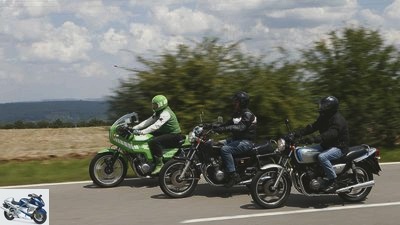
wolf
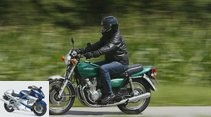
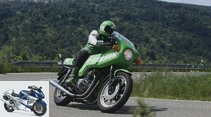
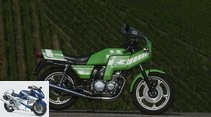
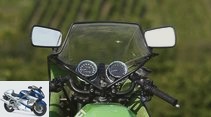
38 photos
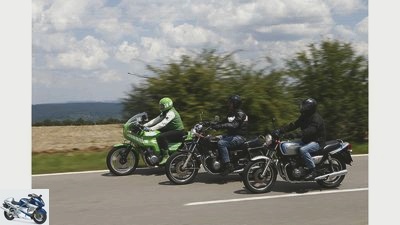
wolf
1/38
A very special family outing – on the go with four different Kawasaki Z 650 models.
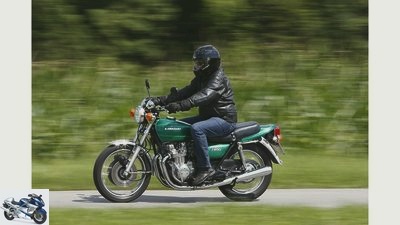
wolf
2/38
The B1 drives beautifully harmoniously, turns in willingly, rushes through curves pleasantly neutral and does not stand up even when braking in an inclined position. The fork, which is very tightly damped on Peters machine, filters away coarse patchwork without leaving any feedback.
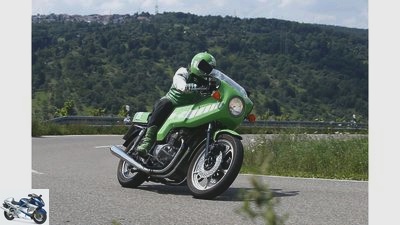
wolf
3/38
Research showed that the sale of the Z 650 LTD was rather slow.
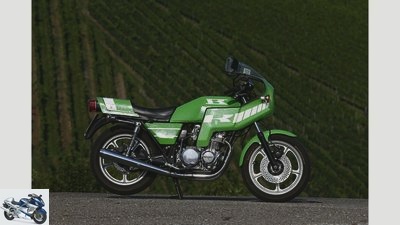
wolf
4/38
There was even talk of one "unsuccessful motorcycle". A twist of the throttle is enough, however, and these lines are old news.

wolf
5/38
Quite rustic: the cladding brackets weren’t exactly filigree. Magura contributed the M handlebars.
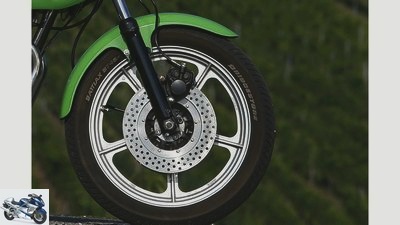
wolf
6/38
Distinguishing feature: The exclusive LTD for 8,100 marks owned these silver Ronal cast wheels with five spokes.
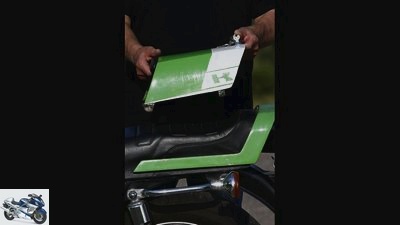
wolf
7/38
Lockable: Under the pillion cover there is a decent place for passengers.
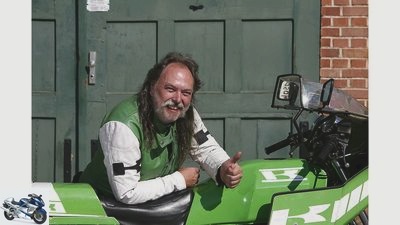
wolf
8/38
Jurgen "Shorty" Briefly about the Kawasaki Z 650 LTD: "I think the Z 650 is great because it can do almost everything. For me, the cup model in particular has a special charm that I rebuilt from a pile of junk. The LTD is rare, and you feel much faster on it. For this I accept the peculiar sitting position."
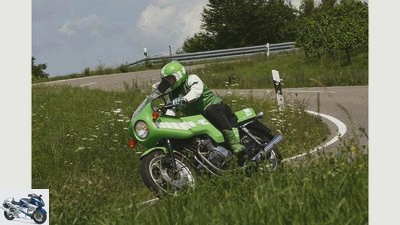
wolf
9/38
The ease of revving of the four-cylinder with slide bearings is astonishing, with the second wind from 7000 tours the tachometer needle zips unrestrainedly deep into the red area.
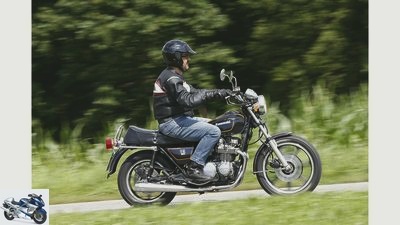
wolf
10/38
The extended caster and the 16-inch rear wheel of the SR are also noticeable in a direct comparison, so the asphalt cowboy demands light counter pressure on the handlebars in tight bends.
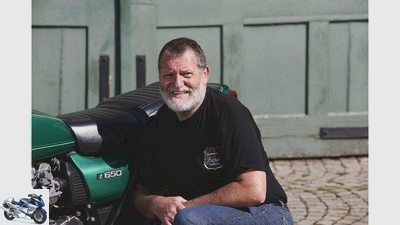
wolf
11/38
Peter Krauss about the Kawasaki Z 650 B1: "The B1 was my first Kawa in 1977. With their duck tail and slim silencers, I find them more elegant than the Z1 or the 1000 series. On winding stretches or passes, I prefer the handy Z 650 to the big bikes anyway, thanks to its easy turning, it can easily keep up with them."
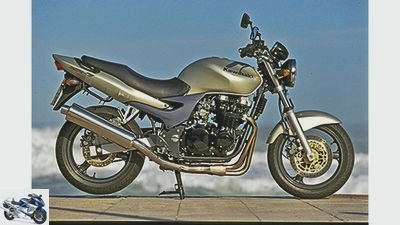
wolf
12/38
1999-2004: The ZR-7 as the last expansion stage of the four-cylinder engine with 76 hp, oil spray nozzles and tensioners for the primary chain. Price 1999: 11,260 marks.
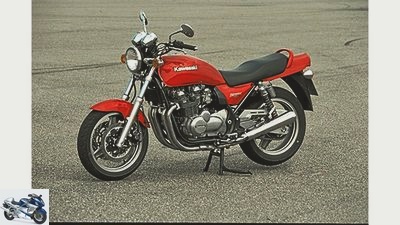
13/38
1991-1999: In the Zephyr 750, the four-cylinder of the Z 650 was revived, which had already been increased to 739 cm³ in 1980. Price 1991: 9990 marks.
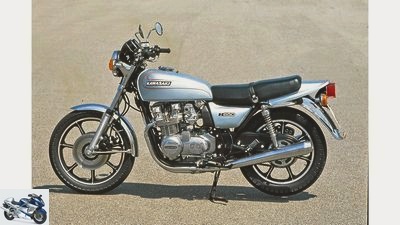
14/38
Not there at the exit, but still a piece of history: the Kawasaki Z 650 C (1978-1979). As an additional variant, the Z 650 C from 1978 with cast wheels and rear disc brake stood by the B1.
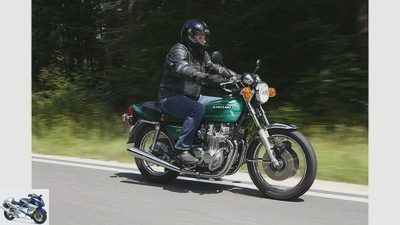
wolf
15/38
Seen a thousand times, but still beautiful! The Kawasaki Z 650 B1.
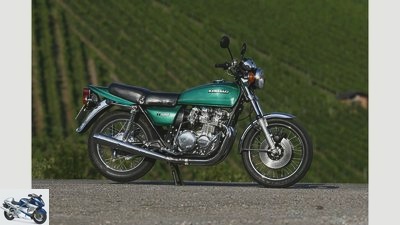
wolf
16/38
Do you really have to be of a certain age to be able to lose yourself again and again in such timeless forms? Apparently yes, if you look at many of today’s bikes, which sometimes give the impression of having come from a manga comic.
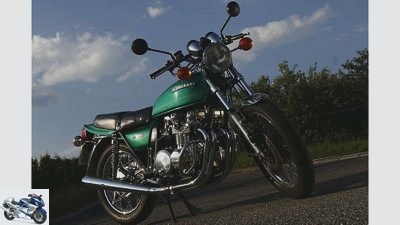
wolf
17/38
What a pleasure, on the other hand, to look at this magnificent, generously ribbed dohc four-cylinder, to follow the slim line of the two silencers with their conical ends or to be dazzled by the gleaming chrome of the exhaust, fenders and the rims of the spoked wheels.
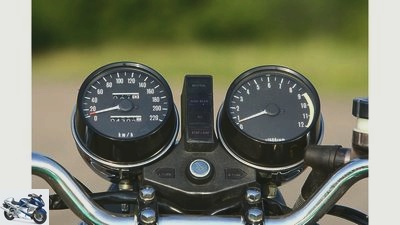
wolf
18/38
Perfectly readable: speedometer, rev counter and six control lamps had to do in 1977.
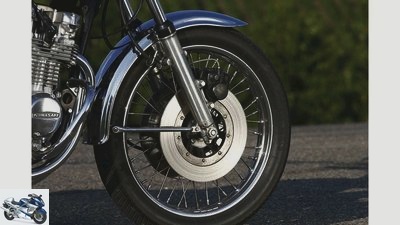
wolf
19/38
Likewise, a single pane at the front, which, after much criticism, received support from a second pane in the same year as part of a free upgrade campaign.
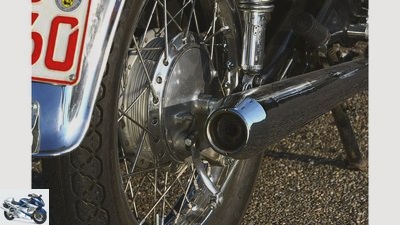
wolf
20/38
Nice to look at: butted silencers and the dohc four-cylinder (clockwise) with generous cooling fins.
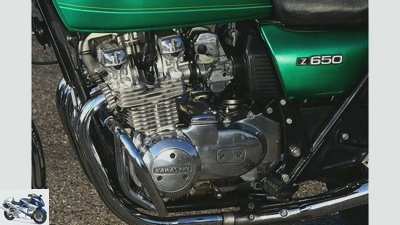
wolf
21/38
In contrast to the big bike, the crankshaft of the 650 series rotates in plain bearings. The primary drive via a toothed chain and the camshaft drive are further distinguishing features. In the Z 650, the two overhead camshafts run directly in the aluminum, and the valve clearance adjustment plates (shims) are very light under the bucket tappets for the benefit of increased revving.
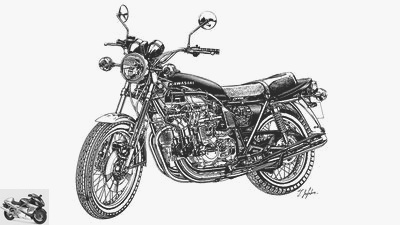
22/38
Durable: The Z 650’s four-cylinder with slide bearings held out as a 750 in the ZR-7 until 2004.
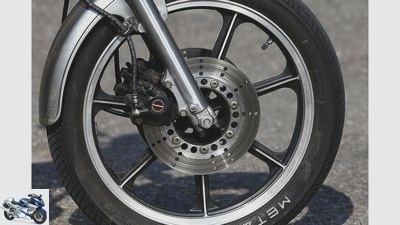
wolf
23/38
The front wheel of the F model.
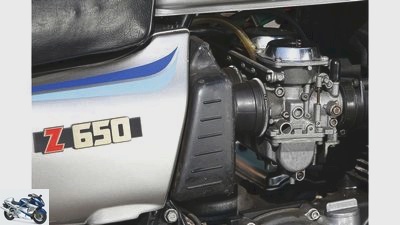
wolf
24/38
From model year 1982 the Z 650 F had constant pressure carburettors, which provided a small increase in performance of one hp.
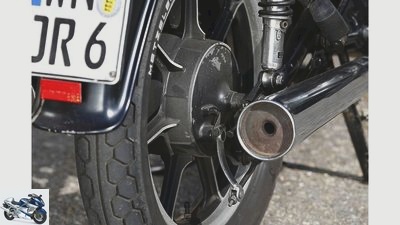
wolf
25/38
The now painted fenders, simpler mufflers and the rear drum brake, however, announced the need to save money in order to be able to offer the Z 650 F for almost 7,000 marks.
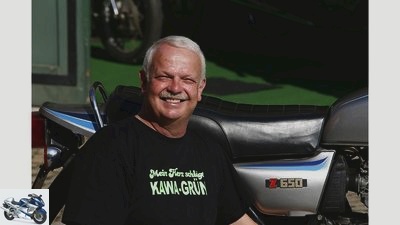
wolf
26/38
Jurgen Reichelt about the Z 650 F: "The F marks the end of the Z 650 story. That is why it belongs with its technical improvements, even if it is a slimmed-down model. As a screwdriver, I am also enthusiastic about the well-thought-out structure and the great accessibility of all parts."

wolf
27/38
A cozy conclusion with the F-model.
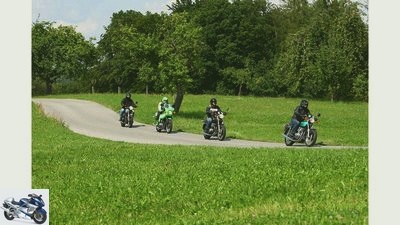
wolf
28/38
The favorite has long been determined in your mind.
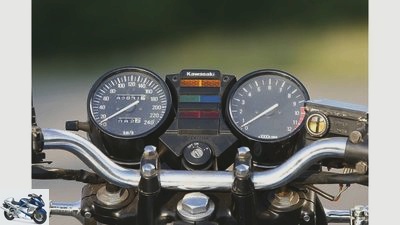
wolf
29/38
New at the F: cockpit, handlebar fittings, air-assisted fork, timing chain with automatic tensioner, H4 light.
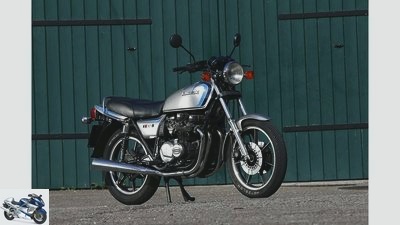
wolf
30/38
In Germany, the technically improved F was back in the range from 1981 to 1984 after a year of abstinence from the classic original model (B / C), with camshaft drive via toothed chain, contactless ignition, air-assisted fork, from 1982 with constant pressure carburetors and 67 hp.
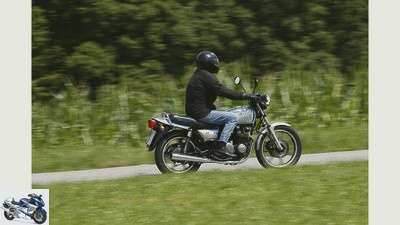
wolf
31/38
The final lap is more pleasant on the F-model, which drives just as well-balanced as the B1.
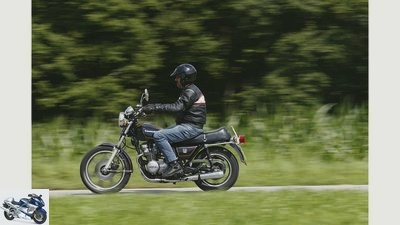
wolf
32/38
Together with the M-handlebars and the standard footrests, this results in an uncomfortable crouching posture, at least for tall people.
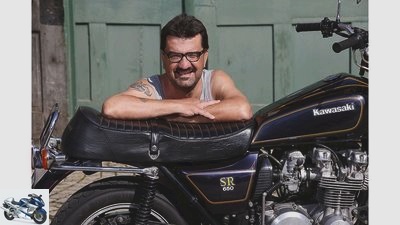
wolf
33/38
Dietmar Kurzenberger about the Kawasaki Z 650 SR: "I like to sit upright and comfortably, the SR fits me very well. I also like their moderate chopper style, which is almost something special today. I think it’s nice that performance and maneuverability hardly suffer, the SR drives no worse than any other Z 650."
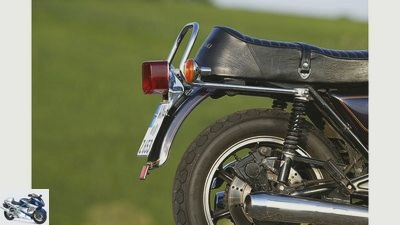
wolf
34/38
Because of the long 24-liter tank, the very best can only be found far back on the angular, slippery bench seat.
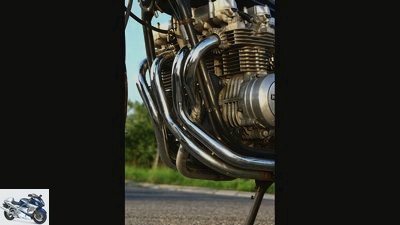
wolf
35/38
Tangled bizarre: The twisted manifold system is characteristic of the SR. The 16-inch rear wheel, stepped bench and high handlebars are also typical.
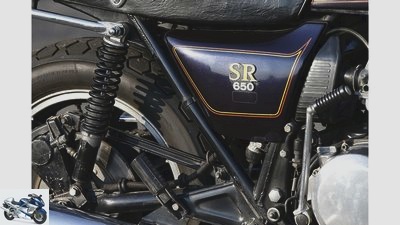
wolf
36/38
New for 1979: the Z 650 SR in soft chopper style. From then on, all 650s had perforated discs and sintered metal brake pads.
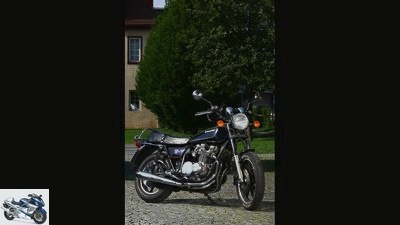
wolf
37/38
In the case of the Z 650 LTD, which was only built 200 times, the noticeable differences are limited to the very idiosyncratic seating position behind the eye-catching cladding.
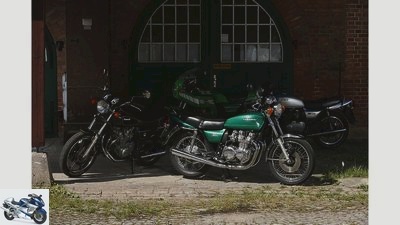
wolf
38/38
The classic B1 goes straight to the heart from the shadow of Z1 and Z 1000.
On the move with the Kawasaki Z 650 family
Because of women’s motorcycle!
Content of
Jurgen Kurz and his friends are very enthusiastic about the Kawasaki Z 650, for them it is much more than just “The Little Prince”. MOTORRAD had once given it this title because the 650 series was always overshadowed by the 1000 series presented at the same time, which was then revered as the king of superbikes.
It’s Tina’s fault. Jurgen “Shorty” Kurz doesn’t have to think twice. Without his ex, the Guzzi and BMW driver would probably not be on the Kawasaki Z 650 came. But then Tina needed a motorcycle that she could get along with without any problems, a girl’s motorcycle. And then such a 650 seemed to be the right thing, after all, some other girls in the extended circle of friends also drove the “little” Kawasaki.
Buy complete article
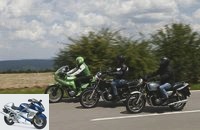
On the move with the Kawasaki Z 650 family
Because of women’s motorcycle!
Kawasaki Z 650 entered the country. Tina is long gone, the enthusiasm for this Kawasaki has remained. Or rather, it has grown steadily, as a glance into the spacious garage workshop shows. The homely gem in an old industrial complex is now home to an impressive “Prince Guard” of ten Z 650 models. Tanks, side covers and rear aprons in almost all lacquer variants add colorful splashes of color, transform the originally quite sober room into a colorful oasis of well-being, in which not only die-hard Z-lovers open their hearts.
A very special family outing
“The first test drive with a Kawasaki Z 650 was really a key experience for me. I was really excited how light-footed and fast it was to drive. In addition, I’ve always liked the 650, precisely because of the similarity to the thousands. Compared to the big bike, however, the prices for these motorcycles were still affordable back then, and parts were even available for an apple and an egg, ”says the 51-year-old, recalling the beginnings of his passion for collecting. It didn’t take long then until he got the 1976 B1 model that he had bought for Tina up and running again for little money.
Only the hiccups in the carburetors, the master shoemaker couldn’t really get a grip on it. But Tina knew another Jurgen who had been working on his two-stroke Kawas for ages. He grumbled a lot about the not quite original condition of the 650s, but turned the right screws – the beginning of a wonderful friendship that the two Kawa-crazy namesake still cultivate in their shared garage.
Four convicts on four Kawasaki
It’s nice for the Classic editor when he can start on a very special family outing with such relaxed and helpful guys. That’s why Jurgen & Jurgen invited her buddy Dietmar and Peter Krauss, the capo from Z-Club Germany. Peters Kawasaki Z 650 B1 from 1977 is still in its original condition except for the mirrors, the chrome cups on the instruments and the Allen screws on the overhauled engine, while Shorty has a contemporary but rather expansive cousin windjammer fairing on the B1 my taste is a little too much of the classic beauty.
Four people with conviction on four Kawasaki Z 650s – well, that can be fun. It will, because the well-humored Kawa quartet welcomes me in an extremely friendly manner and refrains from any missionary zeal. Maybe because they realize that I share their joy with the Kawasaki. Not least as a former Zephyr 750 driver, I’m really excited to see how the ancestor drives. Or, more aptly: the entire 650 family.
Progenitor Kawasaki Z 650 B1
Because in the morning sunlight, four Kawasaki Z 650s shine like one another. Shorty pushed his green cup model next to Peter’s B1. Dietmar loves it more comfortably, which is why he has taken a seat on the lush, upholstered bench of the slightly chopped SR, while Jurgen Reichelt puts a fresh battery in the silver F-model. The F comes from the 1984 vintage, thus marking the end of the Z 650 series. And because of some technical and visual changes, it shouldn’t be missing from this family gathering.
For me, of course, the progenitor, B1, is the focus. Peter’s copy is a great, dignified motorcycle that, despite a light patina – the paint is still original! – exerts a magical attraction on me. Seen a thousand times, but always beautiful! Do you really have to be of a certain age to be able to lose yourself again and again in such timeless forms? Apparently yes, if you look at many of today’s bikes, which sometimes give the impression of having come from a manga comic.
After all, 220 kilograms with a full tank
What a pleasure, on the other hand, to look at this wonderful, generously ribbed dohc four-cylinder, to follow the slim line of the two silencers with their conical ends or to be dazzled by the gleaming chrome of the exhaust, fenders and the rims of the spoked wheels. And then there is that perky swing of the duck’s tail, which makes the Kawasaki Z 650 look a lot lighter than the otherwise similarly styled, larger-capacity brothers.
An impression that is not misleading, the 220 kilogram machine with a full tank is noticeably more agile. From the first meter I feel very comfortable on the Z 650, with my 1.88 meters I sit down nicely relaxed, rather than on the motorcycle, as it used to be. Hands and feet find their place as if by themselves, the ergonomics fit perfectly with the flat handlebars – because of women’s motorcycles!
B1 does not stand up when braking in an inclined position
The best prerequisites for unadulterated fun on bends, which sets in immediately. The Kawasaki Z 650 B1 drives beautifully harmoniously, willingly steers, negotiates curves comfortably neutral and does not stand up even when braking in an inclined position. The fork, which is very tightly damped on Peters machine, filters away coarse patchwork without leaving any feedback. The two discs in the front wheel grip surprisingly well. It was certainly not a mistake that the German Kawasaki importer reacted quickly to the criticism of the standard single disc in the first model year and retrofitted the second disc, including pliers and brake cylinder, free of charge.
The rear dampers, on the other hand, do not work quite as exemplary, here it teeters back and forth without causing the kawa to rock. At least with a species-appropriate driving style, the stable chassis with the double loop frame and the swing arm, which is initially mounted in wear-resistant bronze bushings, does not show any nakedness on country roads.
wolf
Research showed that sales of the Kawasaki Z 650 LTD were rather sluggish.
Which, after the still fresh experience with the Z 750 B (MOTORRAD Classic 5/14), confirms my suspicion that the smaller Kawasakis of that time rewarded their less performance with more driving pleasure and driving stability. In any case, both machines can be chased astonishingly fast and confidently over winding stretches, even if you apply today’s standards.
But back to the Kawasaki Z 650, which reveals a completely different character than the tourist parallel twin. Which of course the once completely newly developed four-cylinder is responsible for. A wonderfully ribbed, symmetrically structured feast for the eyes, the technology of which, despite all the similarity, differs significantly from its big brothers.
The hoped-for success initially failed to materialize
The fact that the four-cylinder with the “crooked” displacement of 650 cubic centimeters at that time lacked 100 cubic centimeters was due to a decision by the marketing strategists who wanted to give the Z 650 a unique selling point. The one that Kawa almost tripped over. Because the hoped-for success initially failed to materialize, the Kawasaki Z 650, offered in 1977 for 6500 marks, sold rather slowly in the first year. I was surprised myself when, in the course of researching the presentation of the Z 650 C and LTD in MOTORRAD 24/1977, I read of “stagnating sales figures” of an “unsuccessful motorcycle” that “made two new versions palatable to potential buyers” should be. A twist of the throttle is enough, however, and these lines are old news.
Many a “potential customer” who was once persuaded to take a test drive must have felt the same way. Because the ease of revving of the plain bearing four-cylinder is astonishing, with the second wind from 7000 tours the tachometer needle zips unrestrainedly deep into the red area. In addition, there is the emotionally very smooth run, which is put into perspective when dismounting, because it then tingles a bit in the fingers. Downstairs, on the other hand, there is calm, even though the short-stroke pulls smoothly through the city even in the last stage of the precise, very short-geared five-speed transmission. But it doesn’t matter because the lively and responsive engine in combination with the neutral and manageable chassis is perfect for sharp cornering.
Emphasizes upright posture on the Kawasaki Z 650 SR
So with a big grin I switch to the comfortable saddle of Dietmar’s favorite, the Kawasaki Z 650 SR. But I don’t really like the emphatically upright posture behind their high handlebars, and the knee angle on the lower bench is a bit sharper. The extended caster and the 16-inch rear wheel are also noticeable in a direct comparison, so the asphalt cowboy demands light counter-pressure on the handlebars in tight bends. Much more serious, however, are the differences in power delivery: The SR pushes forward so vigorously at low speeds as if Shorty had given it more displacement on similarly tortuous paths as with the manifold system. But he swears stone by leg that this is not the case: "The SR is actually the best of all my 650s. In terms of performance, it is probably at the upper end of the series spread. They should also be technically well together."
In the case of the Kawasaki Z 650 LTD, which was only built 200 times, the noticeable differences are limited to the very idiosyncratic seating position behind the eye-catching fairing. Because of the long 24-liter tank, the very best can only be found far back on the angular, slippery bench seat. Together with the M-handlebars and the standard footrests, this results in an uncomfortable crouching posture, at least for tall people. In addition, there is the unfortunate shape of the cladding, which is pulled far back at the sides, which is in the way of the knees and the shift foot when shifting up. So it is difficult for me to imagine that in 1978 at least 40 daredevils wanted to compete with the 8,100 mark LTD in the Z 650 brand cup.
The favorite has long been chosen
I therefore find my final lap on the F-model more pleasant, which drives just as well-balanced as the B1. In Germany, the technically improved Kawasaki Z 650 F was back in the range from 1981 to 1984 after a year of abstinence from the classic original model (B / C), with camshaft drive via toothed chain, contactless ignition, air-assisted fork, from 1982 with constant pressure carburetors and 67 hp. The cockpit, handlebar fittings, the pillion seat bracket and a black engine were also new. The now painted fenders, simpler mufflers and the rear drum brake, however, announced the need to save money in order to be able to offer the Z 650 F for almost 7,000 marks.
It is already dark when we push the 650 back into the garage. In my mind I have long since chosen my favorite – the classic Kawasaki Z 650 B1 drove its way out of the shadow of the Z1 and Z 1000 straight into my heart. If it ever comes to more: After this great day with four great guys, I know exactly who I can blame for it.
Kawasaki Z 650 (1976-1984)
wolf
In contrast to the big bike, the crankshaft of the 650 series rotates in plain bearings. The primary drive via a toothed chain and the camshaft drive are further distinguishing features.
drive
The Kawasaki Z 650 was presented at the IFMA in Cologne in 1976 together with the Z 1000, but it was not a version with a smaller displacement, but a completely redesigned model. In contrast to the big bike, the crankshaft of the 650 series rotates in plain bearings. The primary drive via a toothed chain and the camshaft drive are further distinguishing features. In the Z 650, the two overhead camshafts run directly in the aluminum, and the valve clearance adjustment plates (shims) are very light under the bucket tappets for the benefit of increased revving. To adjust the valve clearance, the camshafts therefore have to be removed, which experience has shown, however, is only required approximately every 30,000 kilometers. If it has to move forward quickly, the short stroke (bore x stroke 62 x 54 mm) needs speeds, the 66 hp of the 652 cm³ two-valve engine are only available at 8500 rpm, the maximum torque of 57 Newton meters at 7000 tours.
The chassis of the Z 650, with its double loop frame, tubular swing arm with two spring struts and telescopic fork, offered nothing special. The weak points in the first model year, however, were the swing arm bearings using bronze bushings and the individual brake disc at the front. After criticism, the German importer added a second disk to the latter at his own expense, which, like needle bearings on the swing arm, was standard on the 1978 B2 model. At the same time, the Z 650 C with cast wheels and rear disc brakes expanded the range.
Purchase check
The Z 650 models are basically among the mechanically solid constructions, even though the control and primary chains produce audible noises, especially when idling, at higher mileages. If these don’t go away at higher speeds, something could be fishy. Attention: On models up to 1980, a roller chain drove the camshafts, for whose tension pulley or gear wheels there are no spare parts or replicas in the event of a defect.
In this regard, the F models, which already have the improved inverted tooth chain with slide bars, are problem-free. A weak point of the Z 650 is the not particularly durable starter freewheel, which requires a lot more time and money to repair than the Z 1 / Z 1000. Inadequate lubrication can leave scuff marks on the camshaft bearings in the cylinder head, and broken threads on their bearing blocks are well known. Beware of problems with the electrical system, the many changes to the cable harnesses make repairs much more difficult, even for experts. You should also know that there is no longer a substitute for scruffy exhaust systems with the conically shaped pots (B, C). And a fall on the right side can irreparably damage the motor housing.
market
The price range for the Kawasaki Z 650 extends from around 2000 euros for decent, ready-to-drive models to around 3500 euros for well-kept types with original exhausts. The market does not (yet) offer much more, whereby the spoke wheel variants are particularly popular.
history
From 1978 onwards, in addition to the B models with spoked wheels, there was the Z 650 C (cast wheels, rear disc brake), and in 1979 the SR was added, which in 1980 remained the only 650 in the range. From 1981 the Kawasaki Z 650 returned as an F model, it had all the technical improvements of the Z 750 presented the year before.
Specialists
Z-Service Frank Bach
www.classicservice.de
Roland Loins
www.lenden.de
Related articles
-
On the move with Honda CB 1100 F and Kawasaki GPZ 1100 B2
www.factstudio.de 29 pictures factstudio.de 1/29 picture gallery: Honda CB 1100 F and Kawasaki GPZ 1100 B2 on the move. factstudio.de 2/29 Honda CB 1100 F and …
-
On the move with a Kawasaki Z 1000 and Zephyr 1100
www.bilski-fotografie.de 36 pictures www.bilski-fotografie.de 1/36 Genetically not related, but they belong to the same family: Kawasaki Z 1000 and …
-
On the move: Benelli 750 Sei, Honda CBX 1000, Kawasaki Z 1300
Bilski 17th photos Bilski 1/17 Who is the widest in the whole country? The angle of spread of the driver’s legs provide information. Bilski 2/17 With…
-
On the move with the Honda CB 900 F Bol d‘Or, Honda CBX, Kawasaki Z 1000 ST and Kawasaki Z 1300
Arturo Rivas 45 pictures Arturo Rivas 1/45 Six against four for first: Honda CBX and Honda CB 900 Bol d’Or. Arturo Rivas 2/45 Honda CBX. Arturo Rivas 3/45 …
-
On the move with Kawasaki GPZ 900 R and Yamaha FJ 1100
fact 39 pictures fact 1/39 Hurry with a while, always slowly with the young horses – sayings like these were definitely not up for debate when the …
-
On the move: Kawasaki W 650 Scambler
Artist On the move: Kawasaki W 650 Scambler In the sign of K Content of Daring but not ostentatious; stylish without ingratiating yourself, this is how…
-
fact On the move: Kawasaki 250TR New classic single-cylinder scrambler from Kawasaki Content of After the unsuccessful Kawasaki Estrella 250, the…
-
On the move with the Kawasaki Z 1000 R.
Wolf 25 pictures Wolf 1/25 Urahn: The roller bearing mounted R-motor is still based on the 900 of the Z1. Bore: once 66, now 69.4 mm. Wolf 2/25 The …
-
On the move: Honda VF 1000 R, Kawasaki GP Z 900 R, Suzuki GSX-R 1100
Jahn On the move: Honda VF 1000 R, Kawasaki GP Z 900 R, Suzuki GSX-R 1100 Technical revolution Content of They drove us crazy – and saved us money:…
-
Jahn On the move: MV Agusta 600 4C motorcycle from the world Contents of Riding out on a touring motorcycle, driven by a four-cylinder …